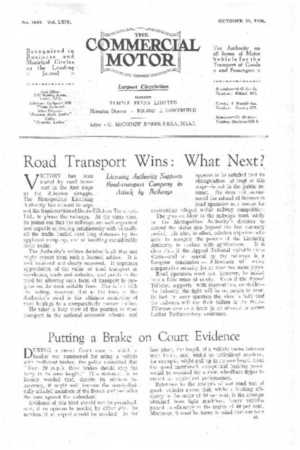Putting a Brake on Court Evidence
Page 35

Page 36

If you've noticed an error in this article please click here to report it so we can fix it.
DURING a recent Court case in which a haulier was summoned for using a vehicle with inefficient brakes, the police submitted that "from 20 m.p.h. these brakes should stop the lorry in its own length." This statement is so loosely worded that, despite its obvious inaccuracy, it might well impress the non-technically minded members of the Bench and prejudice the case against the defendant.
Evidenee of this kind should not be permitted, and, if an opinion be needed by either side, the services of an expert should be invoked. In the 'first place, the length of a vehicle varies between wide limits, and, whilst an articulated machine, for example, might pull up in its own length from the speed mentioned, exceptional braking power would be required for a short-wheelbase tipper to record an equivalent performance. Reference to the analysis of our road test of goods vehicles shows that, whilst a braking efficiency in the order of 50 per cent. is the average obtained from light machines, heavy vehicles record an efficiency in the region of 40 per cent. Moreover, it must be borne in mind that our tests are carried out at a time when the brakes are so adjusted as to be at "concert pitch." The Ferodo chart of braking performances, which is generally accepted as giving accurate data on this subject, shows that from 20 m.p.h. the stopping distance with SO per cent. efficiency is 27 ft.; with 40 per cent. efficiency the stopping distance is 33 ft.
In our -view it would be more satisfactory if, in such cases, the evidence were to be based on the percentage braking efficiency obtained from the type of vehicle in question, and a ruling as to the degree of efficiency that is required would be an invaluable guide to operators. We know from experience the difficulties that are encountered in testing the stopping distances of vehicles from various speeds, and we suggest that drivers and owners should, wherever possible, check carefully the results obtained by the police.
Sporadic Bus Strikes
HOWEVER one may sympathize with any I I legitimate complaint against a grievance, it is impossible to do otherwise than condemn the outbreak of strikes amongst bus personnel. Bus drivers and conductors are virtually public servants, and if they act against the interests of the travelling public, thereby causing considerable inconvenience and disorganization, they will rapidly lose the prestige which they have won by good service over many years.
Such sporadic and unauthorized strikes as have occurred lately, against the advice of the union leaders, merely tend to weaken collective power and security, and considerably reduce the value of the bargaining strength of the men's leaders. It can hardly be expected that great attention will be paid to the elected representatives if they, in turn, cannot exercise sufficient control over their own members to avoid such disturbing episodes. Magnesium Alloy Under Con. sicleration as a Fire Hazard AMATTER of considerable interest to manufacturers and operators of commercial vehicles is referred to in a paper entitled " Elekton Metal Fires," read before the Institute of Fire Engineers by Mr. A. M. Cameron, B.Sc., F.I.C., M.I.Fire E.
The author refers to the fire hazard, which, he states, is brought into being when this magnesium alloy is employed. Results of tests are said to have shown that once the metal ignites it is almost impossible to extinguish the fire. The urgent need for research to be conducted to obtain, if possible, some effective fire-extinguishing medium was empiesized, and reference wa., made to a suggestion for the control of the use of the alloy by suitable regulations to be issued by the Home Office.
The point that has been raised by this authority on fixes and their prevention is one which should • receive the careful attention of all who employ this material. It is used to a considerable extent for gearboxes and other parts of many commercial vehicles, but no case has been brought to our notice in which a fire has actually been caused through its use. We believe that the metal has to be heated to a considerable degree before combustion occurs, and for this to happen the whole vehicle would probably have to be burning thoroughly.
It would appear advisable, however, to follow up the suggestion of research, and it might be found possible to produce some fireproof coating which would assist in reducing any possible danger. The great advantage of this magnesium alloy is its extreme lightness, and it would be regrettable if the precautions necessary to render it more fireproof reduced its value as a factor in cutting down dead weight.




























































































